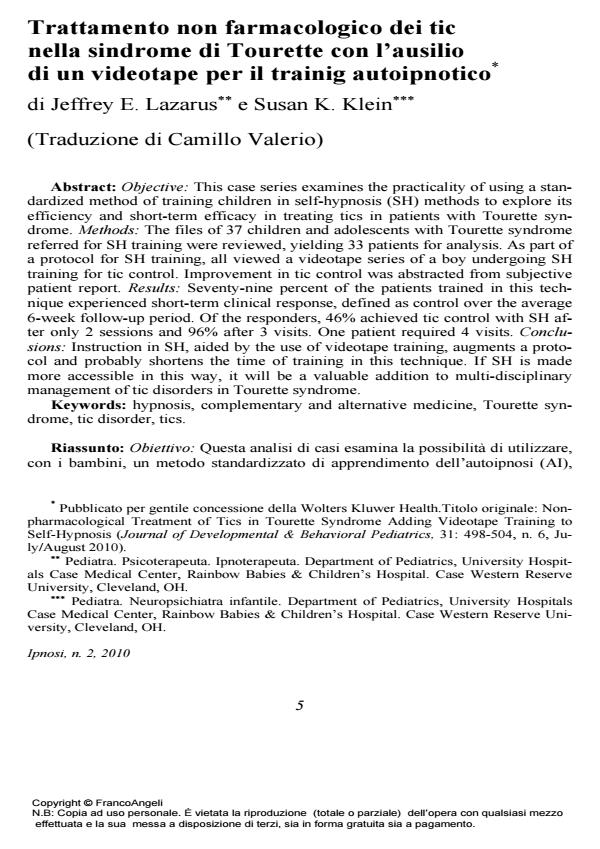Trattamento non farmacologico dei tic nella sindrome di Tourette con l’ausilio di un videotape per il trainig autoipnotico
Titolo Rivista IPNOSI
Autori/Curatori Jeffrey E. Lazarus, Susan K. Klein
Anno di pubblicazione 2011 Fascicolo 2010/2
Lingua Italiano Numero pagine 16 P. 5-20 Dimensione file 568 KB
DOI 10.3280/IPN2010-002001
Il DOI è il codice a barre della proprietà intellettuale: per saperne di più
clicca qui
Qui sotto puoi vedere in anteprima la prima pagina di questo articolo.
Se questo articolo ti interessa, lo puoi acquistare (e scaricare in formato pdf) seguendo le facili indicazioni per acquistare il download credit. Acquista Download Credits per scaricare questo Articolo in formato PDF

FrancoAngeli è membro della Publishers International Linking Association, Inc (PILA)associazione indipendente e non profit per facilitare (attraverso i servizi tecnologici implementati da CrossRef.org) l’accesso degli studiosi ai contenuti digitali nelle pubblicazioni professionali e scientifiche
Obiettivo: questa analisi di casi esamina la possibilità di utilizzare, con i bambini, un metodo standardizzato di apprendimento dell’autoipnosi (AI), per esplorarne l’efficienza e l’efficacia a breve termine nel trattamento dei tic in pazienti con sindrome di Tourette. Metodi: fra 37 bambini e adolescenti con sindrome di Tourette inviati per un training di AI ne sono stati selezionati 33. Come parte di un protocollo per l’apprendimento dell’AI, tutti visionavano videoregistrazioni di un bambino in training autoipnotico per il controllo dei tic. Il miglioramento del controllo del tic è stato desunto dalla risposta soggettiva del paziente. Risultati: ad un follow-up medio di 6 settimane, il 79% dei pazienti addestrati in questa tecnica ha sperimentato un risultato clinico a breve termine definito come "controllo". Tra coloro che hanno risposto, il 46% ha raggiunto il controllo sui tic con AI dopo solo 2 sedute e il 96% dopo 3 incontri. Un paziente ha richiesto 4 visite. Conclusioni: l’insegnamento dell’AI con l’ausilio di videocassette, migliora un protocollo e riduce probabilmente il tempo di training in questa tecnica. Se l’AI è resa in questo modo più accessibile, sarà un valido aiuto alla gestione multidisciplinare dei disturbi da tic nella sindrome di Tourette.
Parole chiave:Ipnosi, medicina alternativa e integrata, sindrome di Tourette, disturbi da tic, tic
Jeffrey E. Lazarus, Susan K. Klein, Trattamento non farmacologico dei tic nella sindrome di Tourette con l’ausilio di un videotape per il trainig autoipnotico in "IPNOSI" 2/2010, pp 5-20, DOI: 10.3280/IPN2010-002001